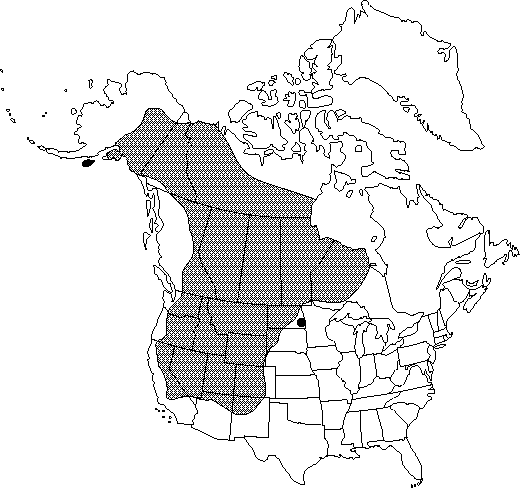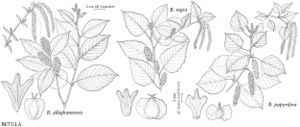Betula occidentalis
Fl. Bor.-Amer. 2: 155. 1838.
Shrubs, spreading, to 10 m. Bark dark reddish brown to bronze, smooth, close, not readily exfoliating; lenticels pale, horizontally expanded. Twigs without the odor or taste of wintergreen, glabrous to sparsely pubescent, covered with conspicuous, reddish, resinous glands. Leaf blade broadly ovate to rhombic-ovate with 2–6 pairs of lateral veins, 2–5.8 × 1–4.5 cm, base truncate to rounded or cuneate, margins sharply and coarsely serrate or irregularly doubly serrate, teeth mostly long and sharp, basal portion untoothed, apex acute to occasionally short-acuminate; surfaces abaxially sparsely to moderately pubescent, covered with minute, resinous glands. Infructescences erect to nearly pendulous, cylindric, 2–3(–3.9) × 0.8–1.5 cm, shattering with fruits in fall; scales glabrous, ciliate, lobes diverging at middle, central lobe narrower and longer than ascending lateral lobes. Samaras with wings broader than body, broadest near summit, extended beyond body apically. 2n = 28.
Phenology: Flowering late spring.
Habitat: Montane stream banks, slopes, and ridges, also in moist open woods, at edges of marshes, along lakeshores, and in wet swales
Elevation: 100–3000 m
Distribution

Alta., B.C., Man., N.W.T., Nunavut, Ont., Sask., Yukon, Alaska, Ariz., Calif., Colo., Idaho, Mont., Nebr., Nev., N.Mex., N.Dak., Oreg., S.Dak., Utah, Wash., Wyo.
Discussion
Betula occidentalis is a common, streamside, shrubby birch throughout much of the Rocky Mountains, extending eastward to northwestern Ontario. It has been widely known by the later name B. fontinalis because of questions concerning the legitimacy of Hooker's epithet (J. R. Dugle 1966). Recent changes to the International Code of Botanical Nomenclature (W. Greuter et al. 1994) have clarified the situation, however, and the consensus now is that the earlier name is correct. E. Hultén (1968) believed that the species in Alaska that has been called B. occidentalis consists of an extensive hybrid swarm between B. neoalaskana (as B. resinifera) and B. glandulosa. The studies of J. R. Dugle (1966) do not support a hybrid origin of B. occidentalis in other parts of its range. Additional study will be needed to resolve this problem, both in Alaska and southward.
Betula ×utahensis Britton (= B. occidentalis Hooker × B. papyrifera Marshall) is a common hybrid marked by intermediate characteristics.
Betula papyrifera Marshall var. subcordata (Rydberg) Sargent, formerly recognized in several state, provincial, and regional floras, consists of introgressants of B. occidentalis into B. papyrifera (J. R. Dugle 1966).
Selected References
None.
